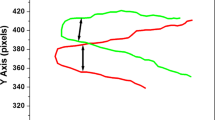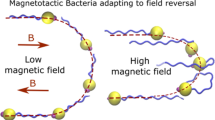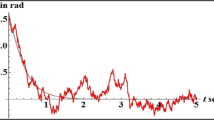Abstract
The movement of magnetotactic bacteria is done in a viscous media in the low Reynolds number regime. In the present research, the simple model for magnetotactic bacteria motion, proposed by Nogueira and Lins de Barros (Eur Biophys J 24:13–21, 1995), was used to numerically simulate their trajectory. The model was done considering a spherical bacterium with a single flagellum and a magnetic moment positioned in the sphere center and parallel to the flagella. The numerical solution shows that the trajectory is a cylindrical helix and that the body Euler angles have linear dependencies on time. Using that information, analytical expressions were obtained for the first time for the center-of-mass coordinates, showing that the trajectories are helixes oriented to the magnetic field direction. They also show that the magnetic moment does not align to the magnetic field, but it precesses around it, being fully oriented only for very high magnetic fields. The analytical solution obtained permits to relate for the first time the flagellar force to the axial velocity and helical radius. Trajectories of uncultivated magnetotactic bacteria were registered in video and the coordinates were obtained for several bacteria in different magnetic fields. The trajectories showed to be a complex mixture of two oscillating functions: one with frequency lower than 5 Hz and the other one with frequency higher than 10 Hz. The simple model of Nogueira and Lins de Barros shows to be incomplete, because is unable to explain the trajectories composed of two oscillating functions observed in uncultivated magnetotactic bacteria.







Similar content being viewed by others
References
Almeida FP, Viana NB, Lins U, Farina M, Keim CN (2013) Swimming behaviour of the multicellular magnetotactic prokaryote ‘Candidatus Magnetoglobus multicellularis’ under applied magnetic fields and ultraviolet light. Antonie Van Leeuwenhoek 103:845–857
Chen YR, Zhang R, Du HJ, Pan HM, Zhang WY, Zhou K, Li JH, Xiao T, Wu LF (2015) A novel species of ellipsoidal multicellular magnetotactic prokaryotes from Lake Yuehu in China. Environ Microbiol 17:637–647
Cui Z, Kong D, Pan Y, Zhang K (2012) On the swimming motion of spheroidal magnetotactic bacteria. Fluid Dyn Res 44:055508
Edwards MR, Carlsen RW, Sitti M (2013) Near and far-wall effects on the three-dimensional motion of bacteria-driven microbeads. Appl Phys Lett 102:143701
Fenchel T (2001) How dinoflagellates swim. Protist 152:329–338
Hindmarsh AC (1983) A systematized collection of ODE solvers. In: Stepleman RS et al (eds) Scientific computing. Noth-Holland, Amsterdam, pp 55–64
Kalmijn AJ (1981) Biophysics of geomagnetic field detection. IEEE Trans Magn MAG 17:1113–1124
Keim CN, De Melo RD, Almeida FP, Lins de Barros HGP, Farina M, Acosta-Avalos D (2018) Effect of applied magnetic fields on motility and magnetotaxis in the uncultured magnetotactic multicellular prokaryote ‘Candidatus Magnetoglobus multicellularis’. Environ Microbiol Rep 10:465–474
Khalil ISM, Tabak AF, Hageman T, Ewis M, Pichel M, Mitwally ME, El-Din NS, Abelmann L, Sitti M (2017) Near-surface effects on the controlled motion of magnetotactic bacteria. IEEE Int Conf Robot Autom (ICRA) 2017:5976–5982
Klumpp S, Lefevre CT, Bennet M, Faivre D (2019) Swimming with magnets: from biological organisms to synthetic devices. Phys Rep 789:1–54
Kong D, Lin W, Pan Y, Zhang K (2014) Swimming motion of rod-shaped magnetotactic bacteria: the effects of shape and growing magnetic moment. Front Microbiol 5:8
Lefevre CT, Bernadac A, Yu-Zhang K, Pradel N, Wu LF (2009) Isolation and characterization of a magnetotactic bacterial culture from the Mediterranean Sea. Environ Microbiol 11:1646–1657
Lins U, Freitas F, Keim CN, Lins de Barros H, Esquivel DMS, Farina M (2003) Simple homemade apparatus for harvesting uncultured magnetotactic microorganisms. Br J Microbiol 34:111–116
Nogueira FS, Lins de Barros HGP (1995) Study of the motion of magnetotactic bacteria. Eur Biophys J 24:13–21
Pan Y, Lin W, Li J, Wu W, Tian L, Deng C, Liu Q, Zhu R, Winklhofer M, Petersen N (2009) Reduced efficiency of magnetotaxis in magnetotactic coccoid bacteria in higher than geomagnetic fields. Biophys J 97:986–991
Su TW, Xue L, Ozcan A (2012) High-throughput lensfree 3D tracking of human sperms reveals rare statistics of helical trajectories. Proc Natl Acad Sci 109:16018–16022
Su TW, Choi I, Feng J, Huang K, McLeod E, Ozcan A (2013) Sperm trajectories form chiral ribbons. Sci Rep 3:1664
Yan L, Zhang S, Chen P, Liu H, Yin H, Li H (2012) Magnetotactic bacteria, magnetosomes and their application. Microbiol Res 167:507–519
Yang C, Chen C, Ma Q, Wu L, Song T (2012) Dynamic model and motion mechanism of magnetotactic bacteria with two lateral flagellar bundles. J Bionic Eng 9:200–210
Zhang WY, Zhou K, Pan HM, Yue HD, Jiang M, Xiao T, Wu LF (2012) Two genera of magnetococci with bean-like morphology from intertidal sediments of the Yellow Sea, China. Appl Environ Microbiol 78:5606–5611
Author information
Authors and Affiliations
Corresponding author
Additional information
Publisher's Note
Springer Nature remains neutral with regard to jurisdictional claims in published maps and institutional affiliations.
Rights and permissions
About this article
Cite this article
Acosta-Avalos, D., Rodrigues, E. On the motion of magnetotactic bacteria: theoretical predictions and experimental observations. Eur Biophys J 48, 691–700 (2019). https://doi.org/10.1007/s00249-019-01394-z
Received:
Revised:
Accepted:
Published:
Issue Date:
DOI: https://doi.org/10.1007/s00249-019-01394-z




